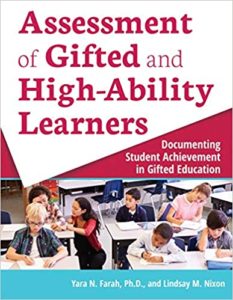Assessment of Gifted and High-Ability Learners
Assessment of Gifted and High-Ability Learners: Documenting Student Achievement in Gifted Education
By Yara N. Farah, Ph.D., and Lindsay M. Nixon
(Prufrock Press, 2019 – Learn more)

Assessment of Gifted and High-Ability Learners is a guide to classroom assessment for instructional decisions. The authors put forth a framework they call Dynamic Teaching, which is a cycle of assessment, evaluation, and decision making.
Material supporting the framework is presented in three main sections: defining the purpose of classroom assessment, sharing examples from content areas, and suggesting small steps educators might take toward change. Checkpoints embedded in each chapter make it a workbook of sorts, offering practitioners scaffolding toward application.
Using a checklist, rating scale and rubric

Pre-service and early-career educators will find the authors’ analogy of a light switch helpful: checklists are like a light switch that is either on or off. Rating scales indicate the degree of performance, and are like a dimmer switch with a range of brightness. Rubrics include descriptive information pertaining to quality, in the way LED and incandescent bulbs offer differing light color qualities.
Of particular interest for teachers of the gifted was the authors’ point that careful construction of rubrics is crucial. A gifted student’s learning and creativity should never be constrained by rubric criteria that are too specific or too limiting.
As a gifted education specialist serving students in grades 8 and 9, I approached this book with an interest in measuring student achievement during and after gifted program participation. One portion of this book that will be useful in my role was an example of student ownership and involvement in elucidating levels of performance. I plan to implement more of these reflection opportunities with my students.
Passing the “Passow test”
I did find myself wondering, however, how this book emerged as a gifted education title. Educators of the gifted frequently refer to the “Passow test” when considering programming for gifted students: Should all kids be doing it? Could all kids do it? Would all kids want to do it?
This notion remained in my mind as I read Farah and Nixon’s book…don’t these precepts about assessment and instructional decision-making apply to any and all students? What makes this framework and its associated examples of particular suitability for gifted and talented learners?
Several questions were left unanswered for me, such as how to assess above grade level within the differentiated classroom, what the authors’ Dynamic Teaching framework might look like in a secondary subject area (most examples were elementary or middle school), and how instructional decision making for gifted learners does or does not follow the same steps as it does for typical learners.
Overall, authors Farah and Nixon present a good foundation of three common assessment tools. Educators seeking additional knowledge in applying checklists, rating scales, and rubrics will find that in Assessment of Gifted and High-Ability Learners, along with step-by-step examples for implementation in elementary and middle school classrooms.
__________
1 Adams, C. M., & Moore, S. D. (2003). Designing and Implementing Curriculum for Programs: Elementary and Middle School Levels. In Joan Franklin Smutny (Ed.), Designing and Developing Programs for Gifted Students. Thousand Oaks, CA: Corwin Press.
Kate Boonstra, M.Ed., (@kateboonstra) is a gifted education specialist in Waukee, Iowa. Her previous roles have included choral director, special education liaison, stay-at-home parent, and the villain in every musical her high school put on.




































